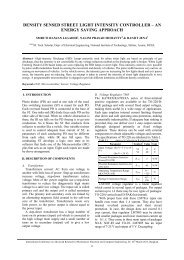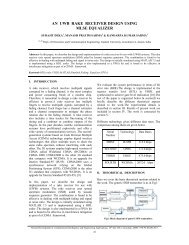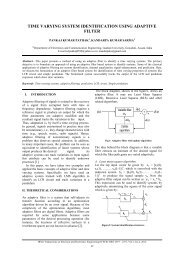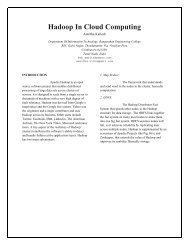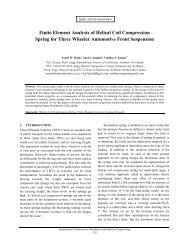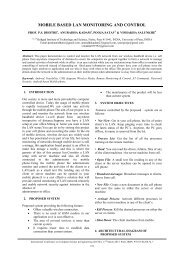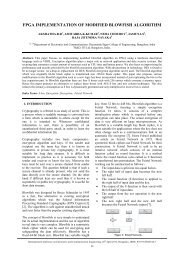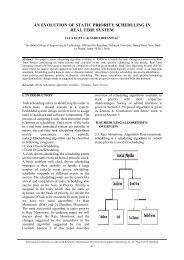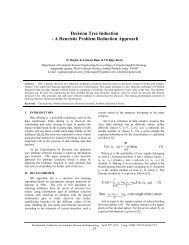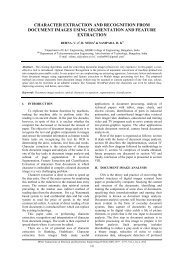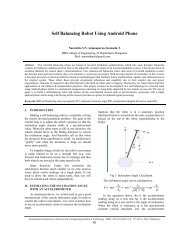tertiary protein structure prediction using a soft ... - IRNet Explore
tertiary protein structure prediction using a soft ... - IRNet Explore
tertiary protein structure prediction using a soft ... - IRNet Explore
You also want an ePaper? Increase the reach of your titles
YUMPU automatically turns print PDFs into web optimized ePapers that Google loves.
Tertiary Protein Structure Prediction <strong>using</strong> A Soft Computational Framework<br />
TERTIARY PROTEIN STRUCTURE PREDICTION USING A SOFT<br />
COMPUTATIONAL FRAMEWORK<br />
ARUNDHATI DEKA 1 , HEMASHREE BORDOLOI 2 & KANDARPA KR. SARMA 3<br />
1,2&3 Deptt. of Electronics & Communication Engineering, Gauhati University, Guwahati-781014,Assam, India<br />
E-mail: arundhati.deka@gmail.com , hbmaini@gmail.com and kandarpaks@gmail.com<br />
Abstract—Protein <strong>structure</strong> <strong>prediction</strong> is turning out to be one of the major challenges in the field of bio-informatics. It is<br />
highly important in medicine, especially in drug design and biotechnology.Proteins, being the basic building unit of all<br />
organisms, require experimental techniques for <strong>prediction</strong> of related <strong>structure</strong>s. Among available methods, <strong>soft</strong>computational<br />
tools provide readily available solutions for making <strong>prediction</strong>s with less complexity, higher reliability and<br />
less time. The Artificial Neural Network (ANN) is one such tool which is used for <strong>structure</strong> <strong>prediction</strong> of <strong>protein</strong>s. This<br />
method is a machine learning approach in which ANNs are trained to make them capable of recognizing the 8-level<br />
subclasses of secondary <strong>structure</strong>. After the subclasses are recognized in a given sequence, their association with 3-level<br />
secondary <strong>protein</strong> <strong>structure</strong>s is derived. The final <strong>structure</strong> is obtained from a majority selection from the <strong>protein</strong> <strong>structure</strong>.<br />
The work is also done in the reverse way, by predicting the 3-level secondary <strong>structure</strong> from the primary <strong>structure</strong> .This is<br />
done to confirm the accuracy of the <strong>prediction</strong>. In this work, ANNs are used as classifier to predict the secondary <strong>structure</strong>.<br />
Keywords-Protein <strong>structure</strong> <strong>prediction</strong>, <strong>protein</strong>ogenic amino acids,DSSP codes<br />
I. INTRODUCTION<br />
Protein <strong>structure</strong> <strong>prediction</strong> is the estimation<br />
of the 3-D <strong>structure</strong> of a <strong>protein</strong> from its amino acid<br />
sequence i.e. <strong>prediction</strong> of secondary, <strong>tertiary</strong> and<br />
quaternary <strong>structure</strong> from the primary <strong>structure</strong>.<br />
The problem of <strong>protein</strong> <strong>structure</strong> <strong>prediction</strong><br />
can be solved experimentally <strong>using</strong> methods such as<br />
NMR Spectroscopy and X-ray Crystallography [1].<br />
Experimental methods are the main source of<br />
information about <strong>protein</strong> <strong>structure</strong> and they can<br />
generate more accurate results. However, they are<br />
also time consuming where the determination of the<br />
<strong>structure</strong> of a single <strong>protein</strong> can take months and they<br />
are expensive, laborious and need special<br />
instruments. Moreover and due to some limitations in<br />
the experimental methods, it is not always convenient<br />
to determine the <strong>protein</strong> <strong>structure</strong> experimentally.<br />
This creates a big gap between the number of <strong>protein</strong><br />
sequences and known <strong>protein</strong> <strong>tertiary</strong> <strong>structure</strong>s. In<br />
order to bridge this gap, other methods are much<br />
needed to determine the <strong>protein</strong> <strong>structure</strong>. Scientists<br />
from many fields have worked to develop theoretical<br />
and computational methods which can help provide<br />
cost effective solutions for the <strong>protein</strong> <strong>structure</strong><br />
<strong>prediction</strong> problem. Machine learning methods such<br />
as ANNs and SVMs are used over the traditional<br />
experimental methods [2], [3].<br />
In this paper, a machine learning approach is<br />
proposed in which ANNs are trained to make them<br />
capable of recognizing the 8-level subclasses of<br />
secondary <strong>structure</strong> and their association with 3-level<br />
secondary <strong>protein</strong> <strong>structure</strong>s is derived. The final<br />
<strong>structure</strong> is obtained from a majority selection from<br />
the <strong>protein</strong> <strong>structure</strong>. In the reverse way, the 3-level<br />
secondary <strong>structure</strong> is also predicted from the primary<br />
<strong>structure</strong>.<br />
II. BASIC THEORETICAL CONCEPTS<br />
A. Protein <strong>structure</strong><br />
Proteins are the basis of all organisms. They<br />
take part in all biological processes inside the human<br />
body. All <strong>protein</strong>s are polymers of amino acids i.e.<br />
amino acids are the basic building blocks of <strong>protein</strong><br />
.There are 20 different amino acids. Every <strong>protein</strong> is a<br />
unique chain of these 20 amino acids. They differ<br />
from one another in the number and sequence of<br />
amino acids. Depending on the number and sequence<br />
of amino acids, every <strong>protein</strong> has different shape and<br />
chemical properties [4]. The sequence of amino acids<br />
of a <strong>protein</strong> represents a biological information unit.<br />
This information creates the unique <strong>structure</strong> of<br />
<strong>protein</strong>s which determines its activity (chemical<br />
properties) in the organism. Basically <strong>protein</strong>s have<br />
four different <strong>structure</strong>s [4].<br />
Primary: The primary <strong>structure</strong> refers to the unique<br />
amino acid sequence of the polypeptide chain. The<br />
primary <strong>structure</strong> is held together by covalent or<br />
peptide bonds.<br />
Secondary: Secondary <strong>structure</strong> refers to highly<br />
regular local sub-<strong>structure</strong>s. These secondary<br />
<strong>structure</strong>s are defined by patterns of hydrogen bonds<br />
between the main-chain<br />
Figure 1: Structures of <strong>protein</strong><br />
<strong>IRNet</strong> Transactions on Electrical and Electronics Engineering (ITEEE) ISSN 2319 – 2577, Vol-1, Iss-2, 2012<br />
58
Tertiary Protein Structure Prediction <strong>using</strong> A Soft Computational Framework<br />
peptide groups. The three secondary <strong>structure</strong>s are:-<br />
alpha helix, beta sheets and coil which are influenced<br />
by the properties of each amino acid.<br />
Tertiary: Tertiary <strong>structure</strong> refers to threedimensional<br />
<strong>structure</strong> of a single <strong>protein</strong> molecule.<br />
The alpha-helices and beta-sheets are folded into a<br />
compact globule.<br />
The three dimensional <strong>structure</strong>s are responsible for<br />
the functional characteristics of <strong>protein</strong>s.<br />
Quaternary: It is composed of two or more subunit<br />
of <strong>tertiary</strong> <strong>structure</strong>s.<br />
The different <strong>structure</strong>s of <strong>protein</strong> are shown in Fig.<br />
1.[5]<br />
B. Proteinogenic amino acids<br />
The word <strong>protein</strong>ogenic means "<strong>protein</strong><br />
building". Proteinogenic amino acids can be<br />
assembled into a polypeptide through a process called<br />
translation [6]. Proteinogenic amino acids are those<br />
amino acids that can be found in <strong>protein</strong>s. There are<br />
22 standard amino acids, but only 21 are found in<br />
eukaryotes. Of the 22, 20 are directly encoded by the<br />
universal genetic code. Humans can synthesize 11 of<br />
these 20 from each other or from other molecules of<br />
intermediary metabolism. The other 9 must be<br />
consumed in the diet, and so are called essential<br />
amino acids. Amino acids are molecules containing<br />
an amine group, a carboxylic acid group and a sidechain<br />
that varies between different amino acids. The<br />
key elements of an amino acid are carbon, hydrogen,<br />
oxygen, and nitrogen [7].<br />
C. Folding of <strong>protein</strong>s<br />
Proteins are an important class of biological<br />
macromolecules present in all organisms. Each<br />
<strong>protein</strong> has a unique linear sequence of amino acids,<br />
also called a polypeptide. This amino acid sequence<br />
contains information that guides the <strong>protein</strong> to fold up<br />
into a unique shape. To be able to perform their<br />
biological function, <strong>protein</strong>s fold into one or more<br />
specific spatial conformations. To understand<br />
Figure 2: Folding of <strong>protein</strong><br />
the functions of <strong>protein</strong>s at a molecular level, it is<br />
often necessary to determine their 3-D <strong>structure</strong>. The<br />
folding of <strong>protein</strong> is shown in Fig. 2.[8]<br />
The unique <strong>structure</strong> of each <strong>protein</strong> is<br />
required for the specific task that it must perform in a<br />
living organism [8]. In genomic bioinformatics, the<br />
function of a particular <strong>protein</strong> can be predicted by<br />
homology technique. It follows the rule that if the<br />
<strong>structure</strong> of <strong>protein</strong> x, whose function is known, is<br />
homologous to the <strong>structure</strong> of gene y, whose<br />
function is unknown, one could infer that y may share<br />
x's function. the parts of a <strong>protein</strong> responsible for<br />
<strong>structure</strong> formation and interaction with others can be<br />
determined by homology modeling technique. In the<br />
<strong>prediction</strong> of <strong>protein</strong> <strong>structure</strong> this information is used<br />
once the <strong>structure</strong> of a homologous <strong>protein</strong> is known.<br />
For reliable <strong>prediction</strong> of <strong>protein</strong> <strong>structure</strong> this is the<br />
only way till date.<br />
D. DSSP CODES<br />
The Dictionary of Protein Secondary<br />
Structure (DSSP) is commonly used to describe the<br />
<strong>protein</strong> secondary <strong>structure</strong> with single letter codes.<br />
There are eight types of secondary <strong>structure</strong><br />
that DSSP defines [10]: G = 3-turn helix , H = 4-turn<br />
helix ,I = 5-turn helix, T = hydrogen bonded turn , E<br />
= extended strand in parallel and/or anti-parallel betasheet<br />
conformation, B = residue in isolated betabridge<br />
,S = bend . Amino acid residues which are not<br />
in any of the above conformations are assigned as the<br />
eighth type, ‘Coil'.<br />
E. ANN as a <strong>soft</strong> computational tool<br />
An ANN is a massively parallel distributed<br />
processor that has a natural propensity for storing<br />
experimental knowledge and making it available for<br />
use. It means that:<br />
‣ Knowledge is acquired by the network<br />
through a learning (training) process.<br />
‣ The strength of the interconnections between<br />
neurons is implemented by means of the<br />
synaptic weights used to store the knowledge.<br />
The learning process is a procedure of adapting the<br />
weights with a learning algorithm in order to capture<br />
the knowledge. The aim of the learning process is to<br />
map a given relation between inputs and outputs of<br />
the network [11]. The figure of feed-forward ANN<br />
set-up called Multi layer Perceptron (MLP) is shown<br />
in Fig. 3 [12].<br />
Figure 3: Multi-layer Perceptron<br />
Figure 4: System Model for classifier 1 (1 st approach)<br />
<strong>IRNet</strong> Transactions on Electrical and Electronics Engineering (ITEEE) ISSN 2319 – 2577, Vol-1, Iss-2, 2012<br />
59
Tertiary Protein Structure Prediction <strong>using</strong> A Soft Computational Framework<br />
Figure 5: System Model for classifier 2 (1 st approach)<br />
<br />
<br />
Coding of Proteins: To code the <strong>protein</strong>s an<br />
alphanumeric coding scheme is used. Each<br />
subclass of secondary <strong>structure</strong> is coded with<br />
a unique alphanumeric code. Then the<br />
considered <strong>protein</strong>s are coded with these<br />
coded subclasses.<br />
Training and testing of the <strong>protein</strong> <strong>structure</strong>:<br />
The network is trained with the six coded<br />
<strong>protein</strong>s and then tested to obtain the results<br />
.Two classifiers have been trained for the<br />
purpose. The first classifier is trained with<br />
the eight different subclasses G, H, I, E, B,<br />
S, T, SPACE. The classifier identifies these<br />
eight subclasses. The second classifier is<br />
trained with the coded sequence of the six<br />
<strong>protein</strong>s. This classifier identifies the six<br />
<strong>protein</strong>s. Based on the majority selection, the<br />
secondary <strong>structure</strong> of the <strong>protein</strong>s is also<br />
extracted.<br />
III.<br />
Figure 6: System Model for classifier 1 (2 nd approach)<br />
Figure 7: System Model for classifier 2 (2 nd approach)<br />
PROPOSED MODEL FOR PSP<br />
The work done is summarized by the system<br />
model shown in Fig. 4, Fig. 5, Fig. 6 and Fig. 7. It<br />
consists of several steps as described below:<br />
The work done is a two way approach to confirm the<br />
secondary <strong>structure</strong>. In the first approach, secondary<br />
<strong>structure</strong> is predicted from the 8-level subclass<br />
representation of secondary <strong>structure</strong> .In the second<br />
approach, a reverse way is followed, i.e secondary<br />
<strong>structure</strong>s predicted from the primary <strong>structure</strong>. The<br />
work is done in several steps:-<br />
First approach<br />
Collecting data set: In our work we have<br />
considered six <strong>protein</strong>s that are Myoglobin,<br />
Insulin, Hemoglobin, Porcine pepsin, E.coli<br />
and Glyoxylase resistance Protein. The<br />
DSSP code of these <strong>protein</strong>s are collected<br />
from the <strong>protein</strong> data bank(PDB).<br />
Second approach/Reverse approach<br />
Collecting amino acid sequences of the<br />
<strong>protein</strong>s from the PDB: The amino acid<br />
sequences of the six <strong>protein</strong>s are collected<br />
from the <strong>protein</strong> data bank.<br />
Coding the <strong>protein</strong>s: To code the <strong>protein</strong>s an<br />
alphanumeric coding scheme is used. Each<br />
amino acid is coded with a unique<br />
alphanumeric code. Then the considered<br />
<strong>protein</strong>s are coded with these coded amino<br />
acids.<br />
Training and testing of the <strong>protein</strong> <strong>structure</strong>:<br />
The first classifier is trained with the 20<br />
coded amino acids. This classifier identifies<br />
the amino acids. The second classifier is<br />
trained with the amino acid sequences of the<br />
six <strong>protein</strong>s .It identifies the primary<br />
<strong>structure</strong>s of the <strong>protein</strong>s.<br />
Extracting the secondary <strong>structure</strong>: The<br />
secondary <strong>structure</strong> of these <strong>protein</strong>s is<br />
evaluated based on the tendencies of the<br />
amino acids to form different secondary<br />
<strong>structure</strong>s.<br />
Derivation of final <strong>structure</strong>: Depending on<br />
majority selection from the secondary<br />
<strong>structure</strong> , the final <strong>structure</strong> is obtained.<br />
IV.<br />
RESULTS<br />
The ANN is trained with six <strong>protein</strong> <strong>structure</strong>s.<br />
With these <strong>protein</strong>s during training the ANN shows<br />
100 percent accuracy while the learning phase with<br />
the same set. Using Gradient descent with Adaptive<br />
learning rate Algorithm, training is carried out. The<br />
ANN is given a performance goal of around 10 -<br />
9 which is attained after certain number of sessions.<br />
The configuration of ANN and performance of ANN<br />
are shown in Table I and Table II. The performance<br />
training graphs for the 1 st approach are shown in<br />
<strong>IRNet</strong> Transactions on Electrical and Electronics Engineering (ITEEE) ISSN 2319 – 2577, Vol-1, Iss-2, 2012<br />
60
Tertiary Protein Structure Prediction <strong>using</strong> A Soft Computational Framework<br />
Fig.8, Fig. 9 and Fig. 10. The performance training<br />
graphs for the 2 nd approach are shown in Fig.11, Fig.<br />
12 and Fig. 13.<br />
Fig.14 and Fig.15 shows the comparative bar<br />
graph for the percentage of helical content and<br />
percentage of beta content present in different<br />
<strong>protein</strong>s obtained from the two way approach. The<br />
grey bar represents the theoretical value, the black<br />
bar represents the percentage value obtained by<br />
forward approach and the cyan blue bar gives the<br />
value from reverse approach.<br />
From the bar charts it can be estimated that<br />
the <strong>protein</strong>s Myoglobin, Insulin, Hemoglobin and E.<br />
Coli have higher helical content than the <strong>protein</strong>s<br />
Porcine Pepsin and Glyoxylase. On the other hand<br />
<strong>protein</strong>s Porcine Pepsin and Glyoxylase have higher<br />
beta content compared to the other four <strong>protein</strong>s.<br />
Hence, based on majority content, the secondary<br />
<strong>structure</strong> of the <strong>protein</strong>s can be confirmed. Proteins<br />
Myoglobin, Insulin, Hemoglobin and E. Coli are<br />
alpha <strong>protein</strong>s while pepsin porcine and Glyoxylase<br />
fall under the beta category.<br />
TABLE I: CONFIGURATION OF ANN<br />
ANN<br />
MLP<br />
No. of Training samples 651<br />
Figure 9: Performance graph for Myoglobin, Insulin,<br />
Hemoglobin (1st approach)<br />
Figure 10 : Performance graph for porcine,<br />
glyoxylase,E.coli(1st approach)<br />
Training type<br />
TRAINGDA<br />
Max. no of epochs 2433<br />
No. of hidden layers 4<br />
TABLE II: PERFORMANCE OF ANN<br />
EPOCH TIME MSE<br />
497 5 sec 10 -4<br />
819 8 sec 10 -5<br />
1042 10 sec 10 -7<br />
2433 23 sec 10 -9<br />
Figure 11: Performance graph for 20 amino acids (2nd<br />
approach)<br />
Figure 8: Performance graph for 8-subclasses(1st approach)<br />
Figure 12: Performance graph for Myoglobin, Insulin,<br />
Hemoglobin (2nd approach)<br />
<strong>IRNet</strong> Transactions on Electrical and Electronics Engineering (ITEEE) ISSN 2319 – 2577, Vol-1, Iss-2, 2012<br />
61
Tertiary Protein Structure Prediction <strong>using</strong> A Soft Computational Framework<br />
<strong>structure</strong>s. This work shows how multi level ANN<br />
classifier can be configured for <strong>protein</strong> <strong>structure</strong><br />
<strong>prediction</strong>. Moreover, it also predicts the secondary<br />
<strong>structure</strong> from the reverse way, i.e from the primary<br />
<strong>structure</strong>. The work may be extended to go into deep<br />
insight into <strong>prediction</strong> theory and explore the<br />
three<br />
dimensional <strong>tertiary</strong> <strong>structure</strong> <strong>prediction</strong>s from<br />
the secondary <strong>structure</strong>s. It may include more known<br />
and unknown <strong>protein</strong> <strong>structure</strong>s which shall make it a<br />
reliable set up for research in bioinformatics.<br />
Figure 13: Performance graph for Porcine pepsin, Glyoxalase,<br />
E.coli (2nd approach)<br />
Figure 14: Performance comparison graph for helix<br />
<strong>prediction</strong><br />
Figure 15: Performance comparison graph for beta<br />
<strong>prediction</strong><br />
V. CONCLUSION<br />
This work reflects the uniqueness of the<br />
proposed model functioning with coded sequence of<br />
<strong>protein</strong>s and applied to ANN for <strong>prediction</strong> of 3-level<br />
secondary <strong>structure</strong>s from the 8-level secondary<br />
REFERENCES.<br />
[1] S.Kushwaha and M.Shakya, "A machine learning technique<br />
for Tertiary Structure Prediction of <strong>protein</strong>s from peptide<br />
sequences", in Proceedings of International Conference on<br />
Advances in Recent Technologies in Communication and<br />
Computing, 2009.<br />
[2] H. Bordoloi and K. K. Sarma, ``Protein Structure Prediction<br />
Using Multiple Artificial Neural Network Classifier’’, as a<br />
Chapter of a volume titled Soft Computing Techniques in<br />
Vision Science, Studies in Computational Intelligence, 2012,<br />
Volume 395/2012, pp. 137-146, DOI: 10.1007/978-3-642-<br />
25507-6_12 , 2012.<br />
[3] H. Bordoloi and K. K. Sarma, ``Protein Structure Prediction<br />
<strong>using</strong> Artificial Neural Network’’, IJCA Special Issue on<br />
Electronics, Information and Communication Engineering<br />
ICEICE (3), pp. 24-26, December 2011. Published by<br />
Foundation of Computer Science, New York, USA.<br />
[4] C.Branden and J.Tooze, "Introduction to <strong>protein</strong> <strong>structure</strong>",<br />
2 nd Ed.,Garland Pub.,1999<br />
[5] http://en.wikipedia.org/wiki/Protein_<strong>structure</strong><br />
[6] D. L.Nelson and Michael M.Cox,"Lehninger's principles of<br />
Biochemistry",4th Edition, 2009.<br />
[7] G. Pok, C. H. Jin and K. H. Ryu, "Correlation of Amino Acid<br />
Physicochemical Properties with Protein Secondary Structure<br />
Conformation", in Proceedings of International Conference<br />
on BioMedical Engineering and Informatics, 2008.<br />
[8] http://www.news.cornell.edu/stories/Aug06/ProteinFoldingSc<br />
heraga.kr.html<br />
[9] S. Malkov, M. V. Zivkovic, M.s V. Beljanski, S. D. Zaric:<br />
``Correlation of amion acids with secondary <strong>structure</strong><br />
types,connection with amino acid <strong>structure</strong>", paper preview,<br />
May 24, 2005.<br />
[10] G. Pollastri, D. Przybylski, B. Rost and P. Baldi," Improving<br />
the Prediction of Protein Secondary Structure in Three and<br />
Eight Classes Using Recurrent Neural Networks and<br />
Profiles", Department of Information and Computer Science<br />
Institute for Genomics and Bioinformatics University of<br />
California, Irvine<br />
[11] S. Haykins,"Neural Networks, A Comprehensive<br />
Foundation", 2 nd Ed., Pearson Education, New Delhi,2003.<br />
[12] http://en.wikipedia.org/wiki/File:Artificial_neural_network.s<br />
vg<br />
<strong>IRNet</strong> Transactions on Electrical and Electronics Engineering (ITEEE) ISSN 2319 – 2577, Vol-1, Iss-2, 2012<br />
62





